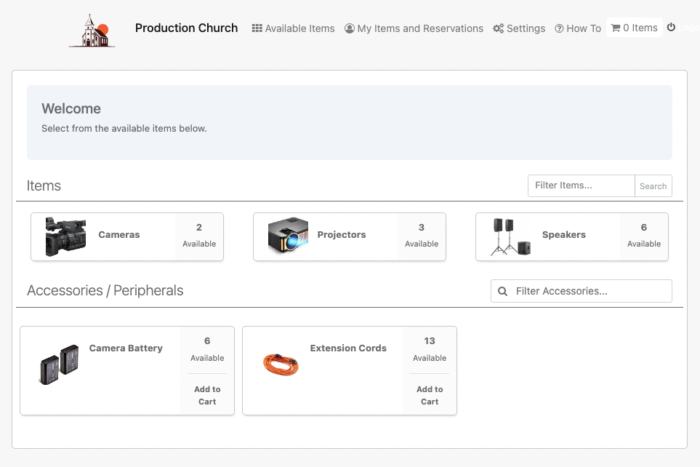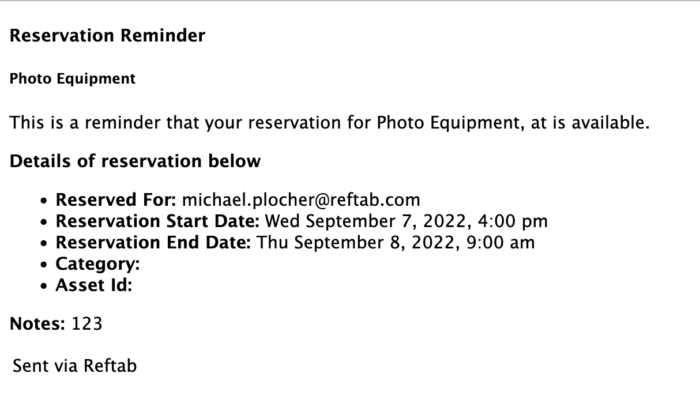A live broadcast can help your church service enter the homes of thousands of congregation members both near and far.
However, the sheer amount of equipment and systems necessary for producing large-scale worship services on streaming platforms, like Facebook Live, Youtube, and Twitch, on a regular basis can be daunting.
From how to best manage all of your equipment to reservations and maintenance, here is a church production equipment checklist to meet your congregation’s needs.
Keeping track of all of the gear that you need
Regardless of whether your church is mostly doing pre-recorded video, think podcasts and sermon videos, or you host full-scale livestreams every Sunday to a rapidly expanding online audience, there’s a fair amount of equipment required.
Though the specifics may vary depending on your church video setup, here are the items that you most likely have on hand:
- Lighting: Individual stage lights as well as a lighting board (console) and dimmer pack to enable audio-visual (AV) teams to control multiple light fixtures simultaneously.
- Video Projector: Minimum of one large-scale screen skirt, projection surface, and projector device to display relevant passages or lyrics to viewers.
- Video Cameras: Minimum of one fancy video camera to film the pastor along with optional cameras placed throughout the venue to film a live congregation or choir.
- Tripods or Monitor Stands: One tripod or monitor stand per video camera and projector to eliminate shakiness in picture quality.
- Microphones: From headset microphones to wireless microphones, there are a lot of different styles of microphones. There is a good chance you’ll need at least two to capture sufficient audio.
- Speakers: Wedge or power speakers for congregation members gathered on stage, subwoofers for those in the venue, and in-ear monitors for the pastor.
- Soundboard and Mixers: A digital sound mixer to mix the input from various microphones, instruments, and pre-recorded tracks.
- A/V Accessories: Encoding device to convert video input into a digital format for playback on multiple devices, velcro cable ties, and various cases for gear.
- Video Editing Gear: Desktop or laptop computer, additional harddrive for storage, and applicable software for editing.
- Power Cables and Cords: Extension cords, a cable snake or cable wrap to control all cords, and a power strip or power conditioner to protect gear in the event of a power surge.
- Batteries: Various battery types depending on equipment needs, such as 12V N batteries for cameras.
Pro Tip: Be sure to also consider the acoustic and visual limitations of your church to construct the best live production.
Setting up equipment management processes
Livestream equipment isn’t cheap. So, you want to make sure you have the right systems and processes so that you always know where your gear is.
How to handle reservations
With a better understanding of the gear you’ll need for a livestream, you can take the first steps to simplifying the equipment reservation process.
We recommend creating a user request portal so that you can keep tabs on who has what equipment and where your gear is all the time.

If you are a smaller church, you may be able to DIY this with a Google Form or spreadsheet. However, if you have a lot of equipment and/or people, you may want to switch to asset management software, where you can set up a more robust user request portal.
No matter which format you use, be sure to include elements like:
- Who is checking the equipment in or out?
- When do they need it?
- What equipment are they taking?
- How long are they taking it for? (i.e. duration)
- When is the equipment due back?
In addition, if you use a spreadsheet like Microsoft Excel, you can simply add another column to indicate when the equipment should be checked in and when it was actually retrieved.
However, if a lot of people have edit access to your check in / check out spreadsheet, this can become problematic as it is easy for things to not get updated in a timely manner or for rows to get deleted by mistake.
That’s another reason why you should invest in asset management software. You don’t have to worry about things falling through the cracks since you’ll have a custom asset / equipment list along with a clear check-in and out process.
Communication and reminders
Another reason to use a custom user request portal over spreadsheets is that you can automate reminders and alerts. For instance, you can send a reminder email or text when equipment is due back along with overdue reminders.

This streamlines communication, establishes better record-keeping, and makes it less likely for equipment to go missing.
Maintenance
The more often your equipment is used, the more likely something will break.
While urgent maintenance or broken equipment is something that no church wants to deal with, every one will at some point. You can keep track of maintenance and out-of-service equipment with spreadsheets, this is time-consuming and can lead to more human errors.
With asset management software, you can see a maintenance log, issue work orders, schedule preventative maintenance (to reduce the chance of equipment breaking at an unfortunate time!) and set up automated triggers.
Simplify your church productions with the proper software
When it is time to hit record, simplify the process with asset management software. Asset management software allows you to keep tabs on all of your equipment along with setting up processes for handling reservations, reminders, and maintenance.
Ready to give Reftab a try? Sign up for a free account here.
